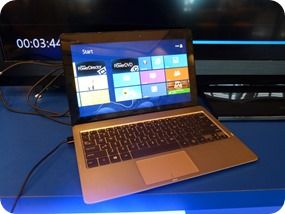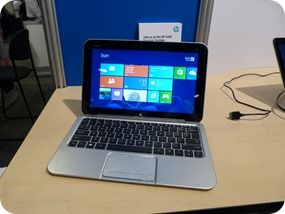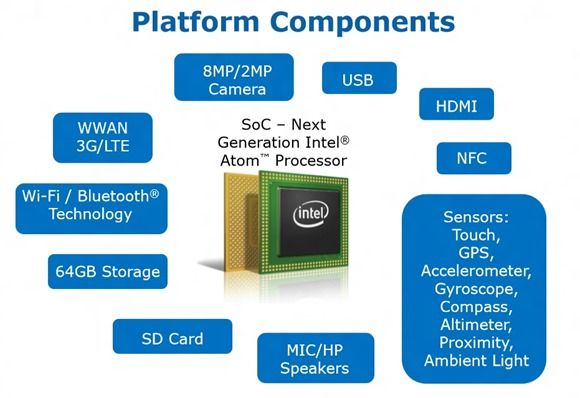Just how long have we been waiting for a low-power productive computing platform and an operation system built to go with it? Atom has been around (largely unchanged in it’s CPU architecture) for many years but we’ve been through Windows XP, Vista and Windows 7 before the OS finally matured to support touch, pen and mouse computing. UMPC’s won’t be coming soon but if the convertible Windows 8 devices do well, there’s a chance that the screen-sizes will drop.
Last week at IDF I took a look at a few of the convertibles and spent a lot of time learning about the platform and analyzing what could be possible.
Videos Asus Vivo Tab, HP Envy X2. Acer Iconia W510 coming too.
ASUS Vivo Tab.
This is my favorite of the Atom-based removable tablet designs.
HP Envy X2
Another good design. This one has the HDMI on the keyboard dock.
Key features of CloverTrail / Windows 8 tablets
The Z2570 dual-core design uses a similar CPU architecture to previous Atoms. We shouldn’t expect too much more performance although the ‘turbo’ to 1.8Ghz and dual-core architecture should be enough to make most people happy. The key here is power and AOAC/Windows 8 Connected Standby. The new architecture has new S0ix power states and combined with new features in Windows 8 should dramatically reduce the idle power, and thus, the average system power.
Windows 8 will also support sensors in it’s Windows 8 Metro applications, there’s NFC support and a number of media enhancements. 1080p 30 FPS video encoding is supported (we’re not sure if this is exposed in the Intel Media SDK) and there’s a image processing unit too. Audio can be offloaded to a hardware unit by Windows 8 Metro apps.
Expect 10+hrs battery life with multi-day online standby!
Having tested the tablets available at IDF this week I’m very interested in the platform. I’ve never been a 11.6 inch tablet fan so a non-removable screen (in the netbook style) is something I’ll be looking out for but I’ll also be expecting to see 10 inch and smaller tablets coming out. I estimate that CloverTrail could support a 7 inch Windows 8 design.














I would love to see a return to small (not just thin!) clamshell devices. The form factor of the old psion series 5 would be almost ideal for me, but with a full version of windows, and a 768 vertical resolution. Please! Thin may be in, but there are other dimensions to think about as well…
64 GB storage it’s not enough for my graphic design
64GB is what the Windows 8 tablets will start with, while RT’s start with 32GB, but some at least will offer up to 128GB and of course microSD/SD card options for expandable storage capacity.
Mind MS also provides Skydrive, and you can still use Drop Box, etc with Windows 8. Along with USB and Network drives… There are even portable WiFi hard drives you can get that will work with these systems, though at a bit of a price premium.
While, since many of the Pro models won’t come out till later then you can probably expect maximum capacity offerings to maybe double by the time they do come out. We’re getting close to the time for the next capacity increase for SSDs, which just like HDDs improve price/capacity ratios over time and steadily increase maximum offered capacities.
well, if i buy now to use a device i am not interested in future to bee’s or not to bee’s. apart from this just one word: one device on the go must be the portable asset and not a cluttering stable of improvisations and additional devices needed.
my netbooks still fulfill just that best (as did the famous psions at their time). it is a pity but also the tristesse of it reality of almost 30 years now.
“We shouldn’t expect too much more performance”
The compute power isn’t that much higher but Windows 8 significantly improves response rate and lot of the Windows 8 devices don’t feature platter HDDs anymore.
Personally after my experience with the S5, I’m not sure I’ll consider UMPCs anymore.
I agree that the s/w and mem / storage components could improve the experience.
Dual-core Atom wasn’t exactly terrible on Win 7 so there are some possibilities here. Certainly Web browsing is going to be high quality and as fast as any ARM tablet.
There’s no totally converged solution in Tablets right now. ARM tablets have software limitations. i86 tablets either have battery life+light weight or desktop-grade power. (Atom vs Core)
At least now though we can have phone, tablet and desktop running a common app suite and cloud storage/sync suites that will make it easier to jump to the device need at the moment.
I’m missing a smartbook in my life so I’m very interested in the new Clover Trail devices. Hoping to test and report soon here on UMPCPortal.
I was originally a major proponent of clamshell designs, but I’ve been thinking lately about the reasons. I think it boils down to two things: 1) You get a keyboard, and 2) the screen is protected.
On my Viliv N5, the screen actually ISN’T protected, because it turns out the keys contact the screen and eventually scratch it up. We could use a basic soft magnetic cover, anyway, to protect the screen.
Also, we’ve had this thing for years where we put a screen onto a system with a keyboard, when it kind of makes more sense to put a keyboard onto a system with a screen. It was probably balance issues that caused that.
Really, a thin pocket-tablet (wait, I suppose it’s called a smartphone) would be best, and then we could add a screen protector with a keyboard. I guess I’m just waiting for an x86 phone with the ability to run Windows (or maybe Windows 8 will run without the legacy PCI bus?) with a USB host port and miniHDMI.
I have frequently thought that the electronics should be behind the screen – preferably will a ribbed aluminum back to act as a heatsink – and a large li-poly battery slice under the keyboard to balance it out and give it all day usage capability. Li-poly cells have been in use in R/C for a decade now, and it is great to see it finally making it into electronics.
I just have no use for a device without a keyboard, and dislike having a separate one to worry about additional batteries and the cost of accessory keyboard docks. Asus, for example wants to make more money on the keyboard than the tablet.
Years ago, I used a Dell X51v with a folding bluetooth keyboard. It was my primary system that got me through college. An old second hand desktop mainly did duty to download and install software on the pocket pc.
Sadly, UMPCs and MIDs priced themselves out of exhistance. I can’t help but wonder though, if a company were to try one again now that there are commodity parts available (the new Atoms are cheaper than ever, and small high resolution screens are all over in the phone and tablet market) it just may be able to establish a good market. Kind of like the netbooks did to the ultra portable space.
Sure, netbooks have died out now, but not until viable replacements started to turn up at reasonable prices instead of the astronomical ones that ultra portables used to be.
Actually, after using the Fujitsu F-07C for a few months I have to say that my first UMPC probably will be the last one. No matter what upcoming “4-5 inch UMPCs” will show up.
Besides the wow-effect Windows at 4.0 inches is totally not usable. Well, you indeed can run x86 based software, it looks quite nasty, but after 15 minutes or less your eyes will regret working with that form factor. Anything else you’d expect from a tiny pc is disappointing as well. The Atom SoC is not even capable of running nearly any 3D based applications. Driver support is not existent.
I am glad I’ve tried the F-07C, but once you’re working on it, you’ll see quite quickly that it’s just a concept device.
I’d recommend 5 inches at least or more for a decent Windows x86 experience. Anything else is gadget dreaming and becoming not very useable under real life conditions.
Example: It takes me 5 minutes to establish a HSPA connection on the go (from Hibernate to Google Chrome) while any Android or iOS based device does that in seconds.
An old HTC Shift or something like that probably would have been more suitable for me.
OK, it’s not 5 minutes at all, but it takes really long to start something up what other devices can do in seconds.